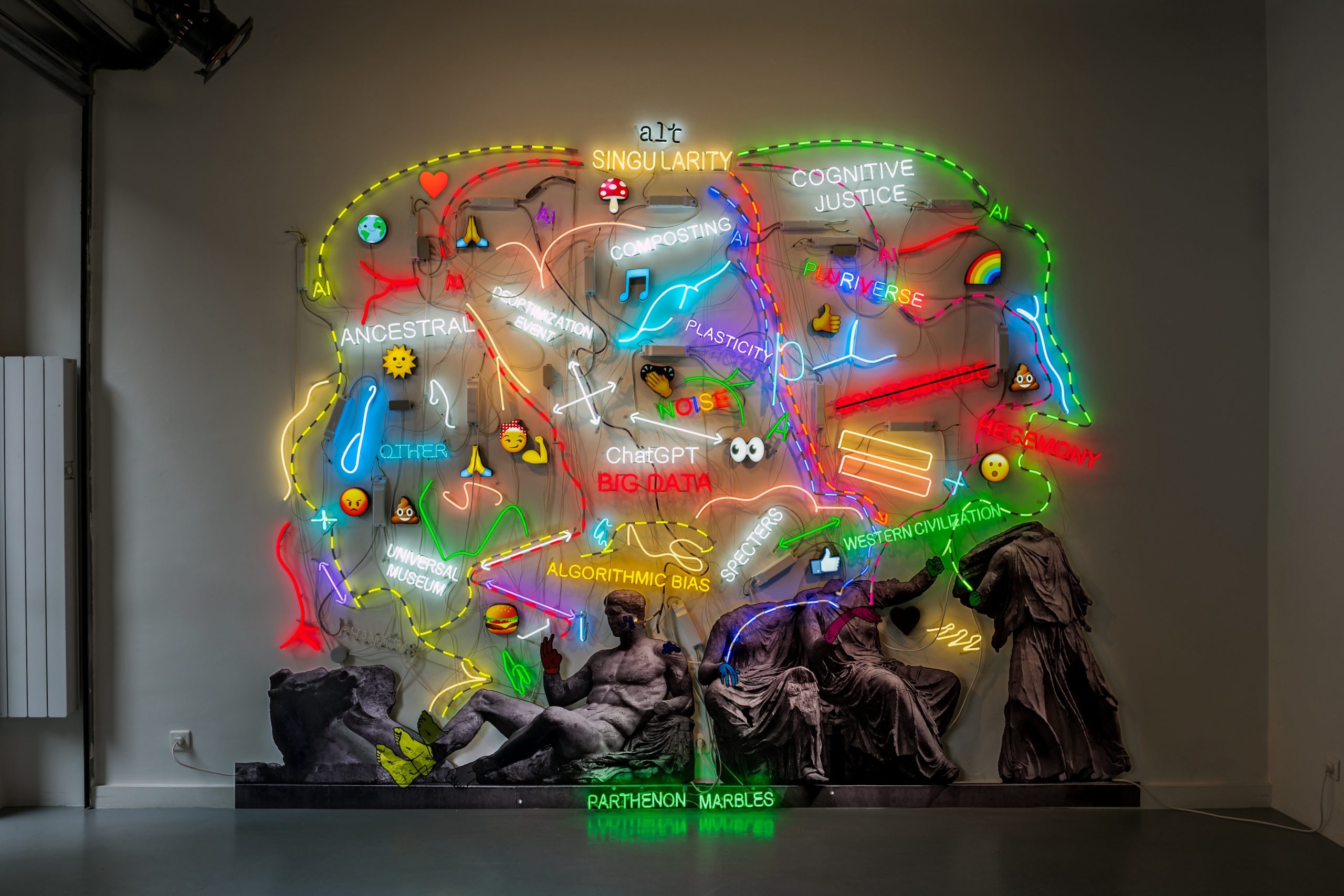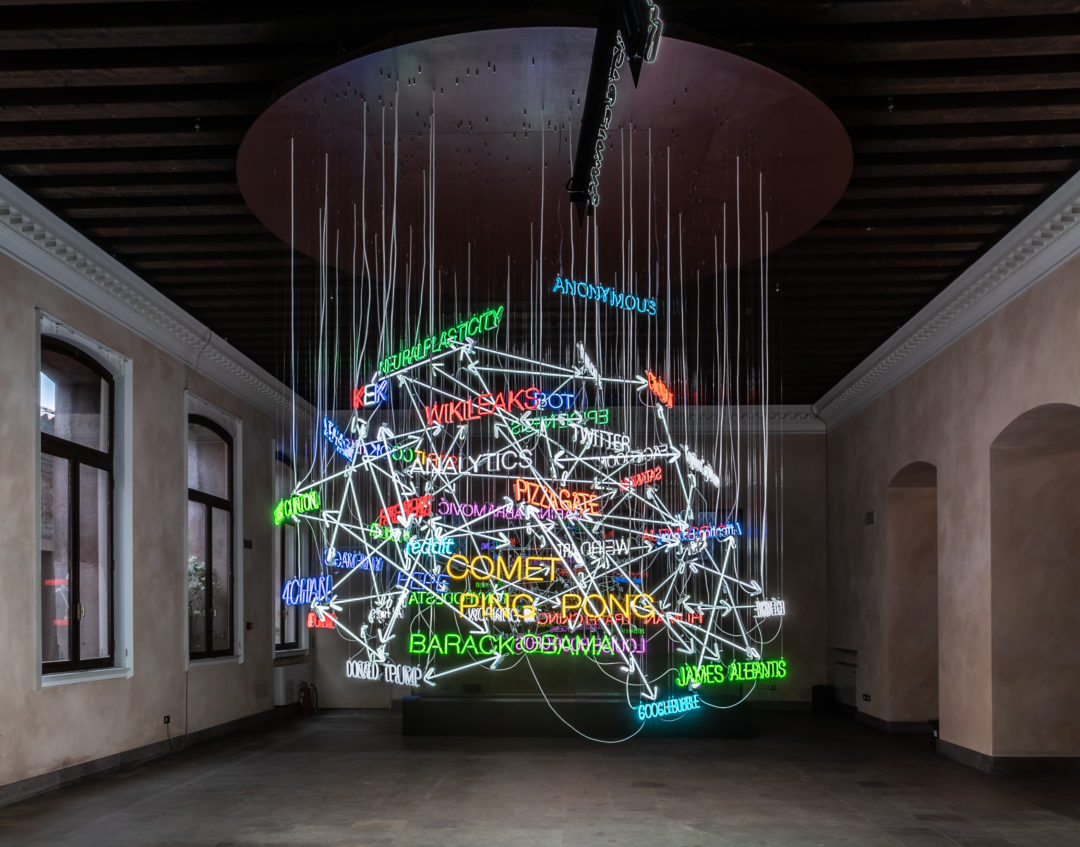Interview with Warren Neidich

Yves Citton: Your past and recent work has devoted a lot of attention to rich intersections between what we can learn (and question) from neurosciences and what we can understand from social processes where economics, finance and politics redefine our conception of work. One of your latest propositions is a concept that I find very suggestive and promising, but which I still have a hard time defining, the concept of “superordinate labor”. Can we start by a brief summary of where this concept comes from and what it refers to in our current historical situation?
Warren Neidich: The superordinate precariat designated an emergent form of subjectivity arising from our added dependence on digitality and screen time especially, in our post-Covid moment. The new habits of media consumption resulting from the combined effect of the increased surge in the use of digital technologies, new social distancing norms, new standard of working at home, digital payment schemes, the streaming epidemic, especially the popularity of Netflix, and the nationwide crackdown and isolation during Covid imposed new pressures on the cognitariat. Additionally, the appearance during this time of ever more sophisticated neural technics, like Big Data, Consumer Neuroscience, Nootropics, Brain Computer Interfaces and Chat GPT, are engaging with a supple intracranial brains’ neural plasticity and neural synaptic diversity on an individual and collective scale for profit. This contemporary engagement of capital, its commoditization and capitalization of the neural commons, is not without pernicious effects. I am suggesting that the new pressures of this neural-digital entanglement are producing a crisis of subjectification in which the cognitariat of early cognitive capitalism is transformed into the superordinate precariat of late-stage cognitive capitalism. The expression “superordinate precariat” has its roots in the etymology of the word “precarious”. As it is used here, the etymology is political in character and describes a subset of the working class emerging during the Regan-Thatcher years. It refers to people who engaged in unstable labor, such as itinerant, short-term workers with zero-hour contracts, whose safety was at best perilous because they relied on wages without non-wage benefits. It was then adopted by the post-Operaismo scholars to describe the contraction of the Keynesian welfare state and the ascension of neoliberalism, in which there is an expansion of contingent and flexible labor markets characterized by permanent insecurity. Whereas, in the earlier time of the welfare State, precarity was the exception, as we move into late-stage cognitive capitalism, it evolves to become the norm.
Y.C. – Thank you for explaining very thoroughly the origin of this mutant type of precariat. I’d like to spend some more time on the qualifier, “superordinate”. What do you mean exactly by “superordinate”, and what does that term tell us about our historical period?
W.N. The reasons why I chose the word superordinate was, as its definition implies, that it is an umbrella term that includes the meaning of other words. Like “pet” is a superordinate of “dog” and “cat”. “Vehicle” is a superordinate concept of “bicycle” and “automobile”. “Dog”, “cat”, as they relate to “pet”, are called hyponyms. In linguistics and semantics, hyponymy shows the relationship between a generic term and a specific instance. Used as a verb such as superordinating or superordinated, it means to elevate an entity to a superordinate position although it is not a designation of powers or new freedoms. I am using the term to express what I consider to be the result of an ontogenetic process which evolves from its specific historical derivation of the precariat mid 1980’s of Reganomics into a larger umbrella term that subsumes those meanings that preceded it and formed its substructure. Such is the etymological lineage of the designatory term precariat. When I was conceiving the expression superordinate precariat, I was really interested in another of its roots: the idea superordinary which means superior to the ordinary, which links into your idea of the emancipation from its antonym, subordinate condition. Superior meaning, in this particular case, a more intense form of vulnerability, uncertainty, instability, insecurity, anxiety and alienation.
A lot of people have been throwing the term “singularity” around, especially in our revelatory moment of Chat GPT. Singularity has its philosophical roots in the word singularization which was adapted by Felix Guattari in his concept of re-singularization to describe the processual emergence of a variety of entities. His idea leads to different modes of living, of a multitude, which is very different from those of standardized and entrenched approaches of conservative socio-political institutions and organizations which create a mass of supple easily controlled people(s).
Philosophical discourse is full of theories of the singularity, such as those of Badiou, Derrida and Nancy. But I have been using this word in my writings and art works as it is used in the exhibition you witnessed at the Priska Pasquer Galley in Paris entitled A Proposition for an alt-Singularity: The Phantom as Other. There, with the expression alt-Singularity, I was resisting its usage in the technopolitical sense, as introduced by Ray Kurzweil and transhuman advocates to designate a moment in which artificial intelligence will overcome human intelligence with possible transformative effects. Kurzweil has hypothesized this happening in 2045. First of all, my definition of the singularity attempts to disrupt it and emanates from a more complex definition, realizing the importance of the human brain in its definition.
For me the singularity concerns not simply the machinic subsumption of human intelligence but includes the moment when human coding power is no longer essential for coding Deep AI. It will be able to do it itself. Machines will code Machines, and not only write code along human prompts, as it is the currently case. Secondly and importantly the code they use may be completely different than those used by humans at this present moment. It will be alien, sublime, faster, less transparent, preventing possibly human intervention in response to it. As such, one of the safeguards of total machinic dominance, human coding, against an ominous dystopic AI future will be removed.
The singularity may also designate that moment in the future when deep learning artificial intelligences like Chat GPT team up with sophisticated forms of Brain Computer Interfaces, cortical implants and other neural technologies to directly affect the brain’s neural material conditions in the future. It is only reasonable to suggest that if the decoded electrical energy of brain waves assisted by brain computer interfaces emanating forth from the brain can be used to direct, through a computer interface, a robotic arm or a wheelchair, then that same energy can move in the opposite direction. An external artificial entity might be used to generate commands in the form of coded electrical energy that would engage with the ongoing functional resonances, in other words, its ongoing local and global electrical activity, that the brain utilizes to function, control and command. If this energy was used during critical periods of brain development, it might be able to sculpt the brains neural plasticity or what I have called in the past “the neural common”. I know this is science fiction, but we are living today what was science fiction of the past. I am calling the singularity that moment when this neural subsumption and its resultant neural precarity becomes operational. This moment is called the Statisticon and represents the ontologic endpoint of forms of despotism that were originally initiated with the Disciplinary Society and continued to the Control Society. Furthermore, the Statisticon is also the endpoint of the technical evolution of forms of overlording used first in the penal architecture of the Panopticon, in the Benthamian and Warkian way as abstract property, and further elaborated in the televisual and spectacular society of the control manifested in the Synopticon.
In the moment of the Internet of Everything, which is now inclusive of data perpetrated by the hyperlinking of intracranial brain and its future extracranial counterparts, the World Wide Web and Virtual Reality, the Statisticon is its moment of full neural-digital entanglement. The superordinate precariat, like the lumpen proletariat of bygone days, is the unfortunate recipient of new forms of despotism and domination.

Y.C. As a further elaboration of Deleuze & Guattari’s Body Without Organs, you introduce the notion of Brain Without Organs. What is it, and how do you manage to articulate the individualist methodology of neuroscience with your own socio-political bend? Aren’t you afraid today’s neurosciences will be tomorrow’s phrenology?
W.N. First of all concerning whether today’s neurosciences will be tomorrow’s phrenology which includes the intertwining of ideology and attitudes towards anato-physiology. In the introduction to my latest book An Activist Neuroaesthetic Reader, I address these matters. My definition of the brain is not, as many neuroscientist understand it, as a material entity restricted to the bony skull defined, measured and investigated solely with and through the use of techno-scientific entrepreneurial dispositifs such as MRI machines, which is ontogenetically static and given. MRI machines are key to the diagnosis of brain anomalies as well as such enterprises as Neural Economics and Neural Consumerism which is highly influenced by neoliberalism or what I have been referring to as neoliberal cognitive capitalism. This approach I refer to as positivist neuroscience and, when it focusses its gaze on aesthetics, positivist neuroaesthetics. Positivist neuroaesthetics attempts to regulate artistic production and the phenomena it produces by bringing them under scientific scrutiny and regimes of knowing. I use the word aesthetics in the same manner as Jacques Rancière does in his book Politics of Aesthetics as distributions of sensibility; a political concept that produces a system of regulated perceptual facts that mold the constituents of a particular society into a uniform entity or people. Today that sensible has extended into the virtual space of the World Wide Web and the stories of social media. My activist definition of the brain is one not restricted to the bony skull but rather is embodied, entangled and extended ecologically with the exterior milieu constituted by social-political-technological relations in flux. It reaches into the deep history of the dust filled universe and the cosmos as well as the microbiota of stomach the so-called “brain in your gut”. I call this brain the situated intracranial-extracranial continuum, and there is no border of demarcation between its elements. The components of the intracranial and extracranial brain coevolve together, as noted by Bernard Stiegler through his early concept of epiphylogenesis which later transitioned into his phrase “exosomatic organogenesis”, in distinction to animal endosomatic organogenesis which is dependent on genetic mutations. Stiegler’s ideas are indebted to Gilbert Simondon’s ideas of individuation and change. As such it is a critique of the single, crystalized, unchanging, positivist, structuralist brain defined by essences and resulting from genetic coding.
This, as you will see, constituted the Brain With Organs. The activist intracranial-extranial complex or continuum is rhizomatic, collaborative, collective and ecological. It does not privilege structural essences and their invariant and pre-individual status but rather concerns change, genesis and becoming. The activist brain is a Brain Without Organs and as such a becoming, networked brain and thus supports notions of convertibility of known structures and the dynamic, vibrant genesis of new ones. Thus, the activist brain is a Brain without Organs and neural plasticity is the basis of its agency. I only use the term Brain Without Organs when I am speaking about emancipating potential of the brain neural plasticity realizing of course that is also has dark and bleak possibilities. I would like to suggest that this has implications for the process of individuation and transformation.
I hope you see where I am going with this as a retort to your question above concerning phrenology and craniometry in relation to ideology and the history of 19th century physiology of Joseph Gall which was later used as a rationalization for the decimation of so called inferior indigenous peoples and later as an excuse by the Nazi propaganda machine for the purification of the Aryan race. Whereas the positivist brain promoted by cognitive neuroscience is subject to measurement and continued scientific programming, the activist brain which I am promoting resists such measurement, containment, and is in a state of flux organized around processes of artistic, cultural and sociogenic emancipation. It so far resists measurement and always in the process of becoming something else. It is not subject to the rules and regulations of the genetic code but rather co-evolves with its extra-cranial components consisting of evolving technologies, political dispositions, cultural leaps and bounds and sociological relations.
The “Brain Without Organs” is term I came up with around 2015, in order to formulate new regimes of resistance and counter insurgency to the new forms of the all-pervasive 24/7 mental labor that the cognitariat is subsumed by. The Brain Without Organs is derived from the notion first proposed by Antonin Artaud and later developed further by Gilles Deleuze and Felix Guattari called the “Body Without Organs”. The Body Without Organs is not adverse or against the body but rather its forms of organization that impose limitations. It is indeterminate, malleable, and ready for change. The Body Without Organs is a live body not a crystalized dead one. I am suggesting that one of the consequences of the Body Without Organs as a conceptual framework was that it disrupted the proletariat body regulated by Taylorist managerial algorithms initiated to increase the workers surplus value. Its changing mutated form of the Body Without Organs could no longer fit comfortably into the schemata of dead labor, the assembly line, with which it was entangled. In cognitive capitalism where the laboring mind and brain have subsumed the laboring body, the Body Without Organs is no longer as important as a means of resistance. Another paradigm is necessary to confront the disabilities and psychopathologies of the cognitariat, as Franco Berardi has called the mental laborer.
The Brain Without Organs is such a construct and subverts the power of neural-digital arrangements and their mental outputs that had subjugated the cognitariat and now the superordinate precariat. The assembly line has been substituted for by the platforms of the World Wide Web. According to Deleuze and Guattari, the problem of the subject was to create an alternative Body Without Organs. The same can be said for the Brain Without Organs. The Brain Without Organs must also create an alternative brain with which to free itself from imprisoning intensities of the material arrangements created by its genetic code the so called Brain With Organs on the one hand, and the politicized socio-political-technological milieu on the other, through which Big Data harnesses the cognitariat operating in an algorithmic induced working environment. The Brain Without Organs is open to change and neural plasticity, and neural variation are its accomplices. In our post-Pandemic world in which we are spending more and more time in front of computer screens, lap tops, desk tops, and iPhones, I would venture to say that Big Data, Big Pharma and the Statisticon are the dominate contemporary apparatuses which are predominately and preferentially sculpting the neural plasticity of the developing brain in order to produce the perfected digital mental laborer whose now normalized brain is seamlessly entangled with the digital overlord.

______________________________________________________________________________
Head image : Warren Neidich, Proposition for an alt-Parthenon Marbles, 2023
Related articles
Céline Poulin
by Andréanne Béguin
Émilie Brout & Maxime Marion
by Ingrid Luquet-Gad
La Contemporaine at Nîmes, Anna Labouze & Keimis Henni
by Elora Weil-Engerer

